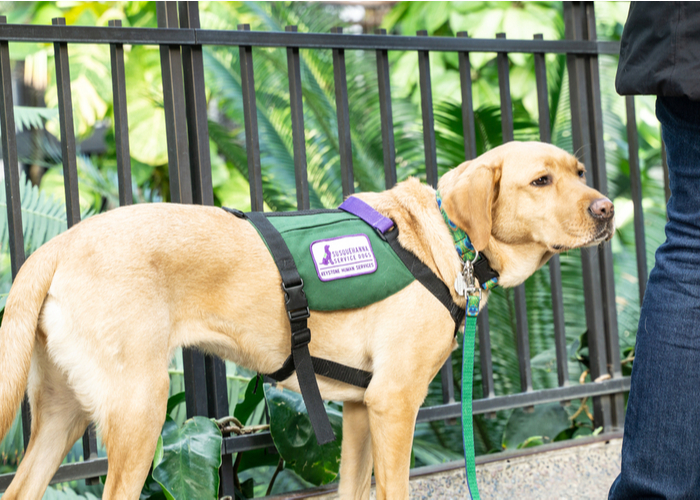Table of Contents
- Emotional Support Animal Sales Notice Requirements According to New California ESA Law
- What is an Emotional Support Animal?
- Emotional Support Animal and a Service Animal Know The Difference
- Emotional Support Dog and a Psychiatric Service Dog Understanding the Differences
- The Difference Between a Psychiatric Service Dog and an Emotional Support Animal
- Identifying an Individual That Requires a Psychiatric Service Dog or Emotional Support Animal
- Can a Pet Become an Emotional Support Animal or Psychiatric Service Dog?
- How Can a Pet Become an ESA?
- Frequently Asked Questions for Emotional Support Animals
- What is in the Americans with Disabilities Act?
- What is the Fair Housing Act?
- What is the Air Carrier Access Act?
- Can I have more than one ESA?
- Submitting a Letter to the Landlord
- What rights do I have with an ESA letter?
- Do I require additional accessories for my dog?
- Do I have to tell my landlord about an emotional support animal?
- What does an Emotional Support Dog Do?
- Can someone ask me about my Emotional Support Animal?
Owners of emotional support animals, you have plenty of rights protected by federal laws.
These laws protect owners throughout every state across the country. For current residents within California, you have even more protection.
California offers additional regulations that accommodate owners of emotional support animals and any other assistance animals.
The recent developments include California's emotional support animal law. Signed on September 16, 2021, the law seeks to address ongoing issues with the selling and misrepresentation of emotional support animals.
These issues include individuals selling or misrepresenting emotional support animals as service animals.
The new ESA Law AB 468 seeks preventative measures against businesses selling special ESA certificates, vests, harnesses, and ID cards that may misrepresent an animal's purpose or intent.
Emotional support animals always hold a vital distinction from service animals, with lesser rights and privileges.
Emotional support animals don't have the specific training for an owner's disability. Several owners will pass off an emotional support animal as a service animal, unaware that it's a misdemeanor offense of wrongfully representing an animal is punishable by fines.
The new law tries to seek further clarification on this distinction.

Emotional Support Animal Sales Notice Requirements According to New California ESA Law
Under the new law, any business providing emotional support to animals must provide a written statement. This documentation must clarify the limitations of an ESA, particularly the differences of a service animal.
A severe change in the new California ESA law impacts all licensed mental health professionals who write or support ESA letters.
Landlords and other professionals require an official ESA letter to keep the animal's role. These letters will now hold additional stipulations:
– All mental health professionals must hold a legitimate and active license to write a supportive ESA letter. These letters must include the type of professional license, effective date, and jurisdiction.
– Professionals must remain licensed to provide professional services within the scope of their license. All letters must report within their jurisdiction where the documentation is provided.
– All professionals must have a relationship with the client for at least thirty days before providing a supporting ESA letter.
– The letter must finalize a clinical evaluation of the client for an emotional support pet.
– All verbal or written notice to the individual similar to the sales notice should be provided to explain the differences between a service animal and an emotional support animal.
What is an Emotional Support Animal?
While every pet owner understands the emotional benefits of having a dog, those with specific mental or emotional conditions can critically influence their ability to function daily.
The particular pet assists with challenges that could otherwise affect the owner's quality of life.
An emotional support animal is a prescribed animal by a licensed medical professional, most often a mental health professional. These services are typically recommended for individuals suffering from disabling mental illness.
A psychologist, psychiatrist, or therapist must determine the influence an animal would hold on an individual's mental health before prescribing such services.
For instance, an emotional support dog might alleviate an individual's anxiety or help them focus on basic life skills. An emotional support dog can be of any breed or age as a service dog.

Emotional Support Animal and a Service Animal Know The Difference
An emotional support dog offers support through companionship and can often help with depression, phobias, and anxiety.
These animals are helpful medically in their own right but significantly different from service dogs. As such, ESA users do not receive the same level of accommodation as service dog users.
A service dog (like a psychiatric service animal or guide dog) is allowed virtually anywhere the general public is allowed.
This includes locations with outside restrictions on animals within the facility. For instance, an ESA is generally not allowed to accompany an owner within a restaurant, while a service dog is welcome.
An emotional support animal is not afforded the same opportunity.
The Americans with Disabilities Act (ADA) defines any service animal as “a dog specifically trained to perform work or tasks for people with disabilities.”
The act holds clear definitions of what constitutes help, stating that animals solely providing emotional comfort do not qualify for the same status.
A few local and state laws will have a broader definition of an emotional service animal, so always check with local government agencies for specific qualifications within your area.
The most significant difference between an emotional support dog and a service dog is whether an animal received specific training for a job or task-specific to the owner's disability.
For instance, a service dog trained to alert a deaf or hard of hearing person to an alarm or aid a visually impaired person around obstacles is considered a service animal.
Behaviors that are solely comforting in nature, such as cuddling on cue, do not qualify under these definitions.
The tasks must be specific to a particular disability or ailment that is not instinctive for a do to perform regularly.
Emotional Support Dog and a Psychiatric Service Dog Understanding the Differences
As service animals must perform specific tasks and services relating to the conditions required by the owner.
These conditions include various ailments, including PTSD, attention-deficit/hyperactivity disorders (ADHD), phobias, autism, bipolar disorder, and obsessive-compulsive disorder.
These might include cancer, deafness, mobility issues, visual impairment, and epilepsy. It also outlines specific requirements relating to emotional and mental illnesses.
With strict guidelines on service animals, only dogs (and, in scarce circumstances, horses) qualify under the definition.
The psychiatric service dog (PSD) must be trained to perform specific tasks, including retrieving medications, reacting and alerting the owner to sounds, reorienting those having a panic or anxiety attack, or locating people.
No one can ask the owner to demonstrate the tasks trained to perform. Outsiders may ask if an individual has a condition requiring the assistance or aid of a PSD, but not the specific situation or severity.
Thankfully, a PSD holds the same rights to stay in places that serve the public. This includes public transit, airplanes, offices, housing, hotels, restaurants, stores, and bars.
The Difference Between a Psychiatric Service Dog and an Emotional Support Animal
An emotional support animal may be a wide variety of species, including cats, rabbits, or birds.
The critical difference between the two types of animals is the tasks performed and the type of animal.
If a dog isn't trained to perform a specific job, it cannot be a PSD. The ADA outlines that no other species outside a canine or horse may qualify for PSD status.

Identifying an Individual That Requires a Psychiatric Service Dog or Emotional Support Animal
Not everyone requiring an emotional support animal will require a PSD. The best way to determine which animal is best suited to your needs is through an evaluation by a licensed medical professional.
Simply describe your symptoms and complete an assessment of the situation to determine your need for a PSD or ESA.
Should the doctor conclude you could benefit from a psychiatric support dog, your medical professional will instruct you on the next steps.
Can a Pet Become an Emotional Support Animal or Psychiatric Service Dog?
Any dog or cat can become an official ESA, regardless of training or history. A doctor can confirm the need for emotional support and help with documentation for emotional support.
Turning a pet into a qualified service animal isn't always straightforward. Only dogs qualify for service animal status, but many pets can undergo training to transition from a pet to a certified service animal.
How Can a Pet Become an ESA?
An individual must receive a prescription for the emotional support animal from a qualified medical professional.
The prescription must indicate that the animal will help or improve a mental or emotional illness. Many ESAs will start with a basic questionnaire, offering validation and certification status after investigation.
Frequently Asked Questions for Emotional Support Animals
Any housing benefits and conditions are within the Fair Housing Act. All animals qualifying as Emotional Support Dogs must have an ESA letter from a mental health professional.
To better understand the different qualifications and requirements of an emotional support animal, here are the most commonly asked questions:
What is in the Americans with Disabilities Act?
Although Emotional Support Animals are frequently used as an imperative component for medical treatment plans, they are not considered Service Animals under the ADA.
ESAs work to provide companionship, relieve loneliness, and occasionally help with anxiety, depression, and occasionally phobias.
Unfortunately, they don't offer the same qualification of training that Service Animals do, preventing the same protections through the ADA.
What is the Fair Housing Act?
Emotional support animals are protected under the Fair Housing Act. This act prevents landlords from discriminating against individuals with disabilities and the service or emotional support animals they may require.
What is the Air Carrier Access Act?
The Air Carrier Access Act works to prohibit commercial airlines from discriminating against individuals with disabilities.
The ACAA currently protects Service Animals against discrimination, specifically those trained to perform specific acts to assist people.
An emotional support animal is not recognized as a service animal under federal law, barring them from protection.
As of January 11, 2021, the U.S. Department of Transportation regulations has shifted the allowance of Emotional Support Animals onboard flights.
Before booking, contact the airline for a list of current policies for boarding with an Emotional Support Animal. These conditions will vary from airline to airline and state to state.
READ MORE: No More Emotional Support Animals on Planes
Can I have more than one ESA?
It is scarce for a therapist to approve more than one emotional support animal.
This condition is primarily because of the extreme difficulty in justifying more than one animal as clinically necessary for support.
Additionally, housing authorities frequently push back hard when prescribed more than one ESA.
Submitting a Letter to the Landlord
Once you receive the Emotional Support Animal Letter from your medical professional, photocopy the document for your records.
Always present the letter to your landlord immediately in person, when possible. Most landlords are extremely accommodating with these requests.
What rights do I have with an ESA letter?
As HUD states that Emotional Support Animals require reasonable accommodation, your letter entitles you to live with the ESA despite ‘no pets' policies. Landlords cannot charge tenants a pet deposit or fee for having an ESA.
Do I require additional accessories for my dog?
The ESA letter is the only thing legally recognizing your pet as an emotional support animal. ID cards and vests are not necessary, although they can make your experiences in public easier.
This recognition will help the public identify your pet as a “working animal” instead of a pet trying to break the rules.
Do I have to tell my landlord about an emotional support animal?
As a renter, those requiring a service animal or emotional support animal can keep the animal in a no-pets policy building.
The Fair Housing Act forbids a landlord from discriminating based on age, race, sex, nationality, or disability.
Legally, a landlord can't stop you from having an animal that officially assists your mental or physical health.
What does an Emotional Support Dog Do?
An emotional support animal can help owners manage stress and worry, reduce loneliness, provide a positive distraction from anxiety, offer a sense of purpose, or offer companionship and physical contact for the owner.
They can also help improve feelings of belonging and increase self-esteem. Most of these behaviors relate to standard pet traits and are not exclusive to service dogs.
Can someone ask me about my Emotional Support Animal?
By law, people may inquire about the need for an emotional support animal but may not ask for specifics relating to the illness or aid of the pet.
An owner must show the ESA letter, signed by a mental health professional, to confirm the status but doesn't have to justify the requirement to anyone.
Always consider your local or state guidelines about protections and rights if you're unsure.













